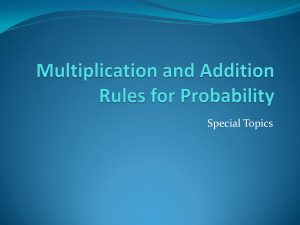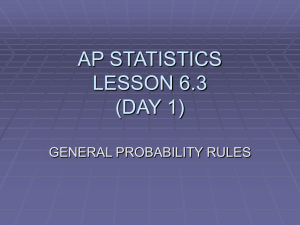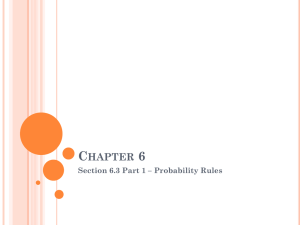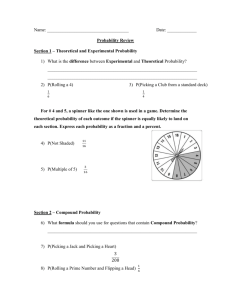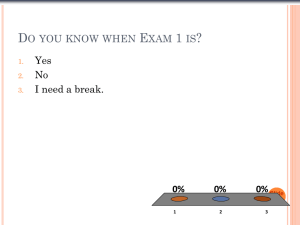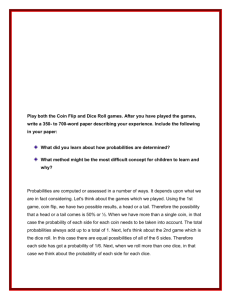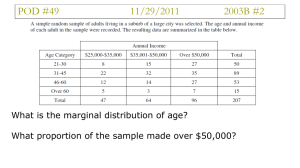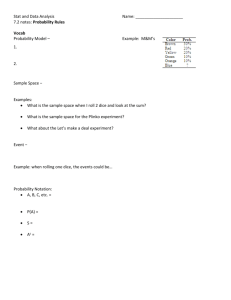Chapters 14 & 15 Notes Filled In
advertisement
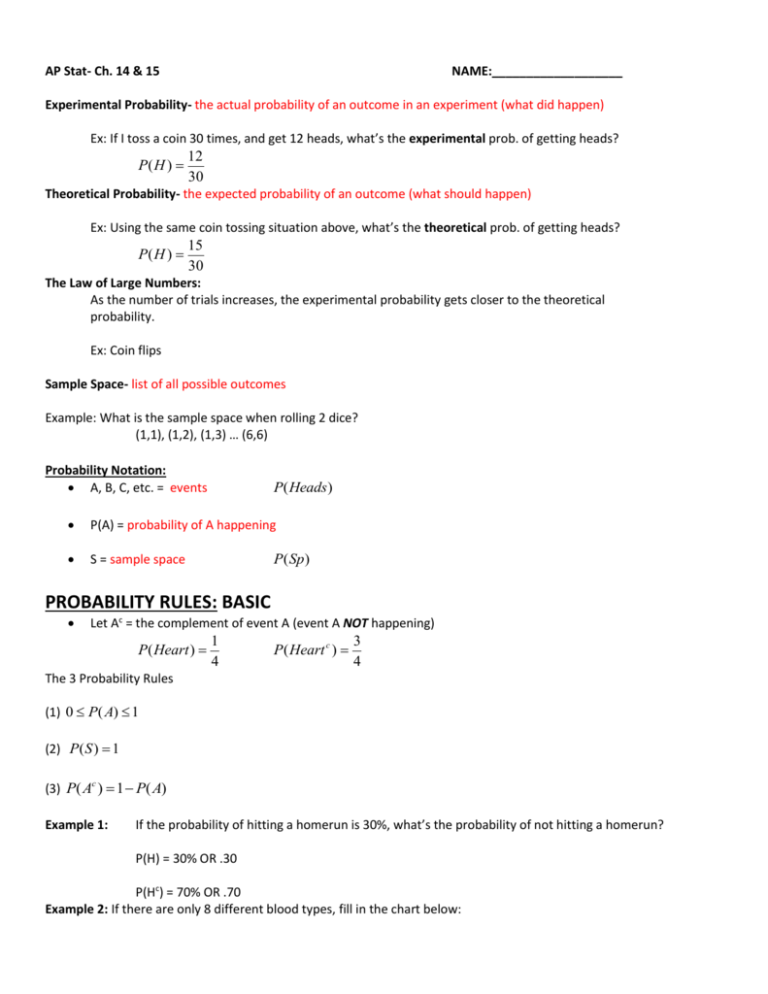
AP Stat- Ch. 14 & 15 NAME:___________________ Experimental Probability- the actual probability of an outcome in an experiment (what did happen) Ex: If I toss a coin 30 times, and get 12 heads, what’s the experimental prob. of getting heads? P( H ) 12 30 Theoretical Probability- the expected probability of an outcome (what should happen) Ex: Using the same coin tossing situation above, what’s the theoretical prob. of getting heads? P( H ) 15 30 The Law of Large Numbers: As the number of trials increases, the experimental probability gets closer to the theoretical probability. Ex: Coin flips Sample Space- list of all possible outcomes Example: What is the sample space when rolling 2 dice? (1,1), (1,2), (1,3) … (6,6) Probability Notation: A, B, C, etc. = events P( Heads ) P(A) = probability of A happening S = sample space P ( Sp ) PROBABILITY RULES: BASIC Let Ac = the complement of event A (event A NOT happening) P ( Heart ) 1 4 P ( Heart c ) 3 4 The 3 Probability Rules (1) 0 P( A) 1 (2) P( S ) 1 (3) P( Ac ) 1 P( A) Example 1: If the probability of hitting a homerun is 30%, what’s the probability of not hitting a homerun? P(H) = 30% OR .30 P(Hc) = 70% OR .70 Example 2: If there are only 8 different blood types, fill in the chart below: Type A+ Probability Example 3: P( NCSt ) .10 A0.16 B+ 0.14 B0.19 0.17 AB+ ? AB- O+ O- 0.07 0.1 P( AB) 0.06 Las Vegas Zeke, when asked to predict the ACC basketball Champion, follows the modern practice of giving probabilistic predictions. He says, “UNC’s probability of winning is twice Duke’s. NC State and UVA each have probability 0.1 of winning, but Duke’s probability is three times that. Nobody else has a chance.” Has Zeke given a legitimate assignment of probabilities to all the teams in the conference? Why or why not? P (UVA) .10 P( Duke) .30 *No; the percent’s add up to over 1 Symbols Union: Meaning: addition OR P (UNC ) .60 Symbol: Intersection: Meaning: intersection AND Symbol: VENN DIAGRAMS - Use shapes to represent events - Box around the shapes to represent the sample space (all possible outcomes) Example: P(A) = 0.26 and P(B) = 0.41 and P(A B) = 0.10. Draw the diagram below. A B Example: P(A) = 0.32 and P(B) = 0.61 and P(A B) = 0.22 P(A U B) = P(Ac B) = P(AC U B) = P(Ac Bc) = P(Ac U Bc) = 0.11 Example: Real estate ads suggest that 23% of homes for sale have fireplaces, 65% have a second bathroom, and 13% have both features. What is the probability that a home for sale has … A second bathroom and a fireplace? P( B F ) 0.13 Neither a second bathroom nor a fireplace? F c ) 1 (0.65 0.23 0.13) 0.25 P( B c A second bathroom but no fireplace? P( B F c ) 0.52 PROBABILITY RULES: UNIONS Example: For a deck of cards, when picking 1 card, what is the probability of picking a red card OR a face card? P(red ) P( face) P(red & face) General Rule: P(A U B) = P( A) P( B) P( A 26 12 6 32 52 52 52 52 B) Special Case: are What if A and B don’t overlap? So, P(A B) = 0 Example: Picking a red card and a spade P(red ) P( spade) 26 13 39 52 52 52 This is called Disjoint = (or mutually exclusive)= Two events are disjoint if … they have no outcomes in common Disjoint events: P(A U B) = P( A) P( B) Example: We are picking one card out of a standard 52-card deck. What’s the probability of picking… A heart or a spade? P ( H A 3 or a spade? P(3 S) A Queen or a King? P (Q A red card or a heart? P( R S) 13 13 26 52 52 52 4 13 1 16 52 52 52 52 K) 4 4 8 52 52 52 H) A black card or a face card? P( B 26 13 13 26 52 52 52 52 F) 26 12 6 32 52 52 52 52 Example: The probability of event G is 0.25 and event K is 0.34. P(G K) = 0.1. What is P(G U K) ? P(G P(G K ) P (G ) P( K ) P(G K ) K ) 0.25 0.34 0.1 0.49 PROBABILITY RULES: INTERSECTIONS & CONDITIONALS CONDITIONAL: P(B|A) = Probability of B happening, given that A already happened P( B A) P( B A) P( A) A = 1st event that happened B = 2nd event that happened REARRANGE INTERSECTION: P(A B) = P( B A)* P( A) INDEPENDENCE = when one event happening does not affect the chance of a second event happening Examples: picking things WITH replacement –coin flips, die rolls, etc. If P(B|A) = P(B) then A and B are independent. Independent events: P(A B) = 0 Example: P(J) = 0.23 and P(B) = 0.67 and P(J|B) = 0.15. (a) What is P(J B)? P( J B) P( J B) P( B) (.15) P( J B) (.67) P( J B) .1005 (b) Are J and B independent? No; because P( J B) P( B) and because P( J (c) Are J and B disjoint? No; because P ( J B) P( J ) * P( B) B) 0 Example: P(A) = 0.45 and P(C) = 0.39 and P(A C) = 0.22. (a) What is P(A|C)? P( A C ) P( A C ) P(C ) P( A C ) (.22) (.39) P( A C ) .5641 (b) What is P(C|A)? P(C A) P( A C ) P( A) P(C A) (.22) (.45) P(C A) .4889 (c) Are C and A independent? No; because P( A C ) P(C ) and because P( A C ) P( A) * P(C ) (d) Are C and A disjoint? No; because P ( A C ) 0 Example: Look at the following table about grade level and favorite type of pet and answer the probability questions: Dog Cat Other Frosh 14 8 12 34 Soph 18 11 14 43 Junior 22 13 10 45 Senior 16 15 9 40 70 47 45 162 (a) If someone is a sophomore, what is the probability they like Dogs the most? P (dogs soph ) 18 43 (b) Given that someone likes Cats the most, what is the probability that they are a junior? P( junior cats ) 13 47 (c) We pick a freshman at random. What is the probability that they like other the most? P (other frosch) 12 34 Example: In a bag of gummy bears, 12 were red, 8 were green, 9 were orange, and 10 were yellow. Find the probability that you … Eat a red bear then a green bear P(red 12 8 * 39 38 Eat a red bear and a green bear P(red green) 12 8 green) * 2! 39 38 Eat 3 orange bears P (3 orange) 9 8 7 * * 39 38 37 Example: Suppose 40% of cars in your area are manufactured in the US, 30% in Japan, 10% in Germany, and 20% in other countries. If cars are selected at random, find the probability that … A car is not US made P(US c ) 0.60 It is made in Japan or Germany What is the probability that a randomly selected student was a girl or from a private school? P( J G ) 0.30 0.10 0.40 You see two in a row from Japan P( J J ) (0.30)(0.30) 0.90 None of the three cars came from Germany P(G c G c G n ) (0.90)(0.90)(0.90) 0.729 At least one of three cars is US made 1 P(US c US c US c ) 1 (0.60)(0.60)(0.60) 0.784 The first Japanese car is the fourth one you choose. P( J c J c J c J ) (0.70)(0.70)(0.70)(0.30) 0.1029 Example: At a local track meet 62% of the participants were girls, 29% of the participants were from private schools, and 18% of the participants were girls from private schools. P(G P) (0.62) (0.29) (0.18) 0.73 What is the probability that randomly selected girl was from a private school? P( P G ) (0.18) 0.2903 (0.62) What is the probability that a randomly selected public school student was a girl? P(G P ) c (0.44) 0.6197 (0.71) Is being a girl and being from a private school mutually exclusive? No; P(G P) 0 Is being a girl and being from a private school independent? Yes; P(G P) P(G ) * P( P) OR Yes; P(G P) P( P) Probability Rules Cheat Sheet: 0 < P(A) < 1 P(S) = 1 P(Ac) = 1 – P(A) UNIONS P(A U B) = P(A) + P(B) – P(A ∩ B) If A and B are disjoint, then P(A U B) = P(A) + P(B) because P(A ∩ B) = 0 INTERSETIONS: P(A ∩ B) = P(A) * P(B|A) If A and B are independent, then P(A ∩ B) = P(A) * P(B) because P(B|A) = P(B) CONDITIONALS: P(B|A) = P(A ∩ B) P(A) P(A) > 0
